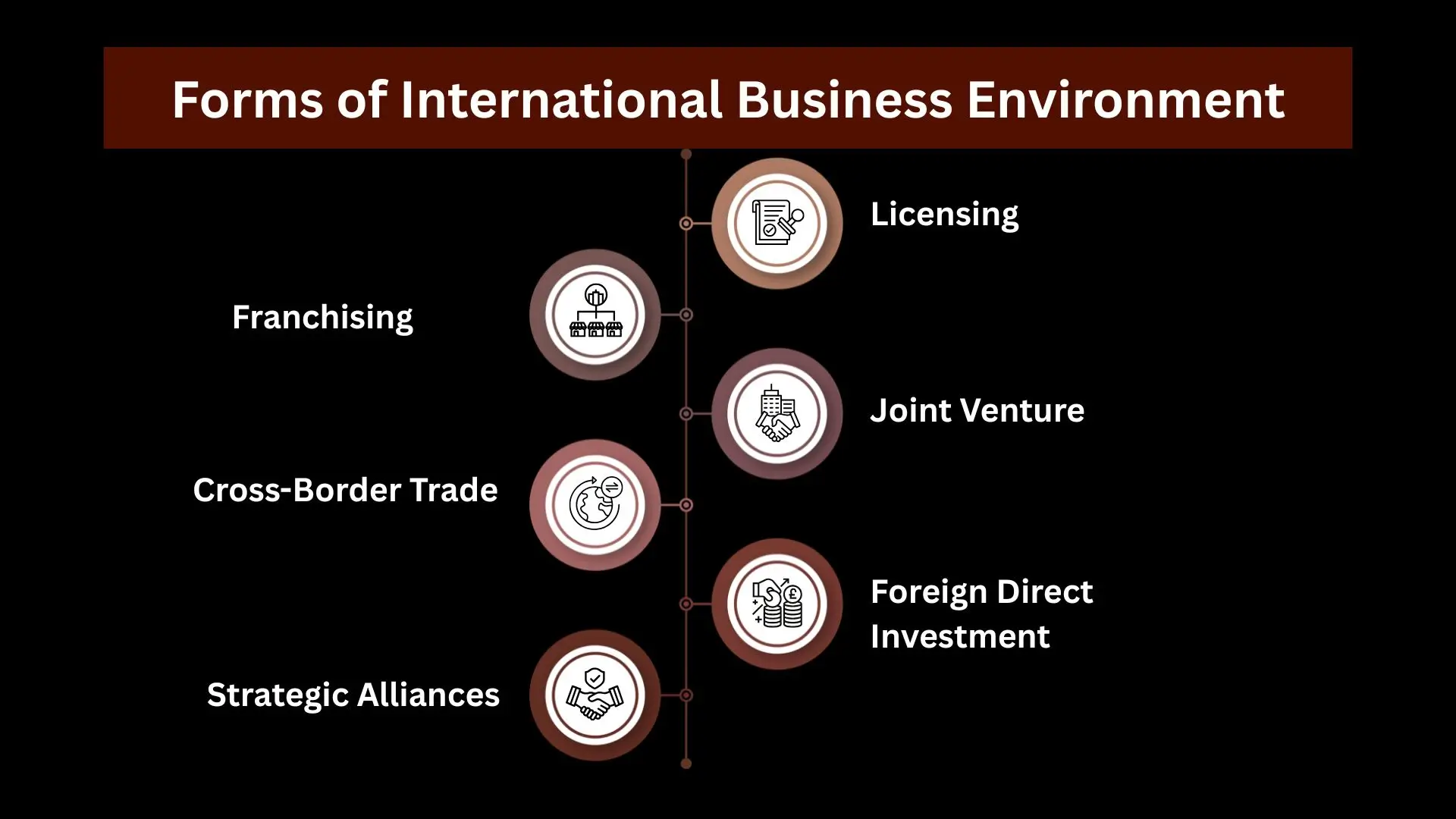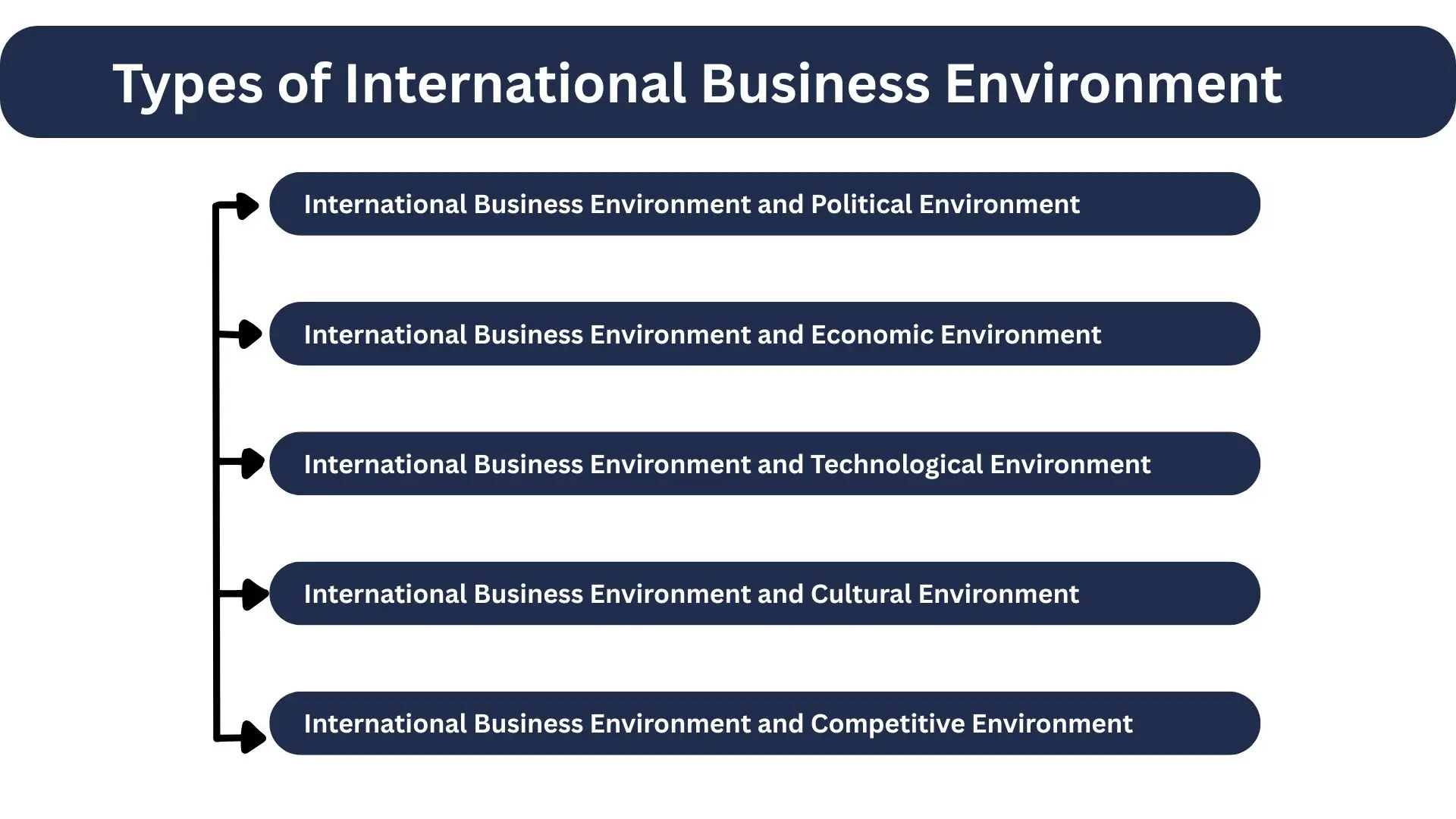
What is International Business Environment?
The international business environment (IBE) is a business environment that represents a multifaceted web of economic, political, legal, and cultural dynamics influencing how organizations engage in global commerce. It encompasses both external and internal factors that significantly influence a company’s prosperity or adversity in diverse markets.
Understanding this concept necessitates grappling with the myriad global forces shaping businesses of all scales. These forces dictate how companies navigate their operations and strategize, spanning from overarching macroeconomic shifts to intricate geopolitical tensions.
With the advent of globalization, businesses increasingly transcend local or regional boundaries, unlocking fresh prospects while simultaneously confronting novel hurdles.
Main Components of the International Business Environment
The economic, political, legal, and cultural factors that influence the international business environment are intricate and influence how corporations conduct their global operations. It encompasses both internal and external elements that affect an organization’s performance in various marketplaces.
Addressing the global factors that affect companies of all sizes is necessary for grasping this notion. These factors, which range from geopolitical conflicts to macroeconomic developments, influence how businesses operate and make decisions.
The fundamental components of the international business environment include:
Political Instability
When growing internationally, it’s important to take political unrest into account. Businesses need to be mindful of how uprisings, war, and other types of conflict might affect daily operations.
Taxes, rules, and labor laws all need to be taken into account when determining a nation’s policies.
Economic Stability
Economic stability is a crucial element in an international business environment and involves a study of trade restrictions, inflation, exchange rates for currencies, and GDP growth rates.
When looking for an appropriate country for operations or investment, businesses must take into account how the economy of other nations may impact their pricing structures and profitability.
Technology
Because of improvements in communication and digital infrastructure, technology is becoming more and more significant in international company operations.
Organizations need to be aware of how implementing new technology may alter their competitive environment or generate fresh possibilities for their goods and services.
Geographical Factors
Another important factor is geography, which has an impact on the logistics of shipping products, accessing fresh markets, and hiring personnel.
Based on the business concerned, the availability of natural resources like minerals or oil must also be taken into account.
Forms of International Business Environment
The different forms of international business environments include- licensing, franchising, joint venture, cross-border trade, foreign direct investment (FDI), export-import trade, and strategic alliances.

- Licensing – A company allows a foreign firm to use its brand, patents, or technology in exchange for royalties (e.g., Coca-Cola granting bottling rights).
- Franchising – A business model where a company (franchisor) grants another party (franchisee) the right to operate under its brand and business system (e.g., McDonald’s, KFC).
- Joint Venture – Two companies from different countries form a new business entity, sharing ownership, profits, and risks (e.g., Sony Ericsson).
- Cross-Border Trade (Export & Import) – Selling goods/services between countries without setting up a local presence (e.g., China exporting electronics to the US).
- Foreign Direct Investment (FDI) – A company invests in or acquires business assets in another country, such as opening a subsidiary or manufacturing plant (e.g., Tesla setting up a Gigafactory in Germany).
- Strategic Alliances – Companies from different countries collaborate on business operations without forming a new entity, often for mutual benefits like market access (e.g., Starbucks partnering with Tata in India).
Read More: Tools for International Business Environment Analysis
Types of International Business Environment
There are various types of international business environments such as:

International Business Environment and Political Environment
The government’s relations with businesses and different political risks are included in the political environment of the business. A businessman will have to deal with different political scenarios and government and their policies when they have to do trade in another country.
They will have to take many things into consideration while doing trade in other countries. This includes knowing the political system of business in that country, incentives offered by the government, government approach towards business, import and export laws of that particular country, formalities for starting a new business in that country, import and export laws, and laws regarding the pricing of the goods.
International Business Environment and Economic Environment
The factors that contribute to the country’s attractiveness towards foreign businesses is different from one country to another country. Higher education levels, better healthcare, usage of high technologies, and better infrastructure systems are part of a better economy.
Better economies attract foreign investors to the country. The more developed countries are rich and underdeveloped countries are poor and the industrializing countries are moving from poor to rich. This categorization depends upon the gross domestic product(GDP) of the country.
A businessman needs to evaluate the economy of the country before starting his business out there.
They also need to consider factors, like the economic system in which they want to start their business and the pace at which the economy is growing in that particular country, GDP levels and per capita income of the country, direct and indirect taxations of that country, availability of raw materials and their supplies, availability of skilled labor in that country, cost of the raw materials, etc.
International Business Environment and Technological Environment
The factors related to the types of machinery and raw materials used in the manufacturing of goods are included in the technological environment.
New technologies often give organizations a fair advantage over others. This is why organizations are competing to get the latest technologies available in the market.
International Business Environment and Cultural Environment
The cultural environment is one of the important components of the international business environment. The general values and beliefs shared by the nation are referred to as the national culture of that country.
There are many factors that influence the formation of core values and beliefs of the nation. These include region, language, political system, history, religion, and education levels.
International Business Environment and Competitive Environment
The competitive environment that exists in a country depends on the political, economic as well as cultural environment of that country.
Different sources constitute the competition among the organizations, it can be from the public or private sector, large or small organizations, and global or domestic organizations.
Benefits of International Business Environments
The benefits of the international business environment are listed below:
1. Strengthens Global Relations
International trade fosters cooperation improves economic conditions, and strengthens diplomatic ties between nations.
2. Boosts Employment Opportunities
Global business expansion creates jobs by increasing the exchange of capital, ideas, and skilled labour across borders.
3. Promotes Equal Wealth Distribution
Encourages balanced economic growth and ensures wider availability of goods and services in different regions.
4. Drives Innovation & Technological Advancements
Exposure to international markets accelerates modernization, stability, and technology transfer worldwide.
5. Expands Business Opportunities
Entrepreneurs can enter new markets, grow their customer base, and increase profitability beyond domestic boundaries.
6. Enhances Product and Service Reach
Businesses gain global exposure, attracting more customers and improving brand recognition.
7. Optimizes Product Life Cycle Management
Companies can extend the lifespan of their products by expanding into new markets when demand declines in domestic regions.
8. Encourages Mutual Economic Growth
Countries benefit from shared expertise, investments, and infrastructure development, fostering long-term economic stability.
Difficulties Faced in the International Business Environment
Hindrance in Communication
Language and cultural differences can create hindrances to communication in international business environments. Translation services can help to ensure that information is accurately conveyed between parties, preventing misunderstandings.
Vibrant Markets
Intense competition is a prevalent feature in international markets, primarily attributed to the diverse economic, political, and cultural dynamics present across various countries.
Currency Exchange Rates
The international business profitability model is sensitive to exchange rate fluctuations. If the difference between the two currencies is too high, the business could incur losses.
Cultural Diversity
International business environments that celebrate multiculturalism and diversity may not always result in successful outcomes. Misalignment between an employee’s cultural beliefs and an organization’s values can lead to workplace conflicts and hinder employee retention and recruitment rates.
Technological environment in an international business environment
The technological environment includes forces related to scientific improvement and innovations which provide a new way of manufacturing products or delivering new services and operating businesses.
Let us take some example
- People using online payment methods instead of paying in liquid money
- People using online shopping platforms instead of purchasing from the market
- Ordering food online and getting it delivered to your doorsteps
- Electronic items got cheaper over the years due to technological advancement
These are some of the examples in which technological advancement has played a huge role. There are many other examples, like technological advancement in healthcare which is saving many people’s life and money. Shifting from offline classes to online classes in the time of the pandemic.
Foreign investors are attracted to highly technologically advanced countries.
Economic environment in an international business environment
The economic environment refers to all forces and fares which directly influence the economy of the country. The economic environment consists of the gross domestic product, national income, productivity and unemployment rates, and industrial, monetary, and fiscal policies of the country.
Some aspects of the economic environment are:
- An increase in GDP would result in the disposable income of the people and the demand for the goods will increase.
- High inflation rates are set as a constraint as it would increase the cost of production of the goods.
- A decrease in the interest rate is beneficial and there would be an increase in the demand for home loans and borrowing money.
- The passing of the GST bill will affect almost all organizations.
- The Demonetization of currencies had a huge impact on the Indian economy.
- The financial sector changes have prompted numerous appealing schemes of lending and depositing money. The offshore bank is offering loans at an extremely low rate of interest and with the least formal documentation.
Competitive environment in the international business environment
The competitive environment comprises the actions of the competitors and how that impacts the businesses irrespective of the domain. This could be direct or indirect competition. In the competitive environment, organizations study each other and do the planning to be at the top of the list.
Example: JIO vs Airtel – this is direct competition in the Indian telecom industry. Sometimes customers benefit from the competition as they would get products or services for a lower price.
Cultural environment in the international business
The cultural or social environment consists of the beliefs and customs in the society in which the business operates. It includes standard of living, education levels, taste, and preference of the society in which the business operates or functions. The businessman cannot overlook elements of the social or cultural environment as these would have an impact on the business in the long run.
For example, many foreign food outlets initially struggled to operate their business in India as their food items were not part of the diet of the common man of India. Hence, they had to change their menu in order to be successful in India. This is not the case just with the food brands.
Even other foreign manufacturers had to alter their product lines in order to be successful in the Indian market. Indian market is very price sensitive and manufacturers have to price their products rightly in order to sustain in the Indian market. Similarly, each country has its own market trends to which brands alter their products, services, and pricing.
Read More: FSSAI License Registration
Purpose of International Business Environment
- Companies can find chances for expansion and develop effective strategies by comprehending the scope of an international business environment.
- Utilizing cultural diversity, businesses can develop distinctive goods and services that appeal to wider customers.
- Comprehending the international business environment can assist firms in enhancing their operational flexibility and innovation so they can remain competitive.
- Having a presence in several markets might give you a competitive edge, such as reduced manufacturing expenses or tax breaks.
- Due to global trade, businesses can take advantage of economies of scale and resource availability.
Conclusion
In this article, we had a glance at the international business environment, forms of the business environment, types of the international business environment, and the benefits of the international business environment. The article has given a good depth analysis of each category mentioned above.
The article has also given details and examples of the economic environment in the international business environment, the competitive environment in the international business environment, and the impact of the cultural or social environment on the international business environment.
This article also emphasizes why people in managerial roles should take decision-based in the international business environments.
FAQ’s
The international business environment refers to the external factors that affect business operations across borders. It includes economic, political, legal, cultural, technological, and competitive forces that shape international trade and investments. Companies must navigate these factors when expanding globally.
The international business environment offers several advantages, including:
- Market Expansion – Access to a broader customer base beyond domestic markets.
- Revenue Growth – Increased sales and profitability through global trade.
- Diversification – Reducing risks by operating in multiple markets.
- Innovation & Technology Transfer – Gaining new skills, processes, and ideas from global markets.
- Competitive Advantage – Strengthening brand presence and staying ahead of competitors.
There are five key types of international business environments:
- Economic Environment – Includes market conditions, GDP growth, inflation, and trade policies.
- Political & Legal Environment – Covers government regulations, trade laws, and stability.
- Socio-Cultural Environment – Includes cultural norms, consumer behavior, and language barriers.
- Technological Environment – Innovation, infrastructure, and digital transformation affecting business.
- Competitive Environment – Rival businesses, market entry barriers, and global competition.
Companies face several challenges in the international business environment, such as:
- Regulatory & Legal Barriers – Complex trade laws and compliance requirements.
- Cultural Differences – Language barriers and varying business customs.
- Economic Instability – Currency fluctuations, inflation, and recessions.
- Political Risks – Trade restrictions, tariffs, and diplomatic issues.
- Logistics & Supply Chain Issues – Managing international shipping, tariffs, and customs regulations.
The key aspects that influence international business include:
- Global Market Trends – Demand for products/services in different regions.
- Trade Policies & Tariffs – Import/export regulations affecting business costs.
- Cultural Adaptation – Understanding local customs and consumer behavior.
- Technological Advancements – Digital transformation and automation in global markets.
- Sustainability & Ethics – Compliance with global environmental and social responsibility standards.

